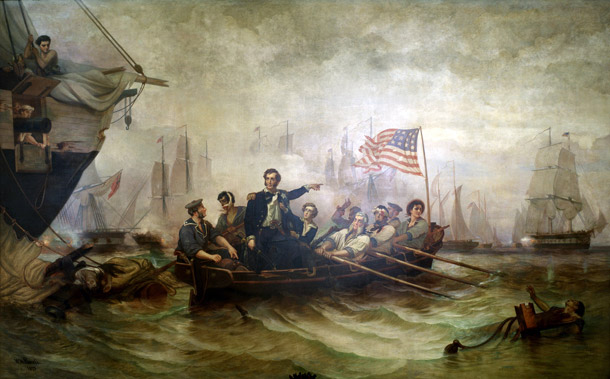If the ocean-going navy buoyed American confidence and patriotism with its victories in salt water, the navy’s performance on fresh water altered the outcome of the war. The Great Lakes were vital arteries to transport men and supplies for the armies of the time. Neither side could prosecute a major land invasion without first securing one or more of the Great Lakes.
In a memorable use of combat rhetoric, Perry sent a short message to General William Henry Harrison—“We have met the enemy and they are ours”—words repeated in history books ever since.

US Senate
On a number of occasions, the British under Sir James Yeo and Americans under Isaac Chauncey maneuvered for position on Lake Ontario, fired upon one another, and seemed poised to fight. But in each instance, one or the other pulled back, believing his opponent had an advantage. This stalemate, along with victories on Lake Erie and Lake Champlain, ensured that the United States would not lose any territory as a result of the army’s bungling.
After the American surrender of Detroit by General William Hull on August 16, 1812, the British dominated all of Michigan and the upper Great Lakes. The only way to drive the British back was to control Lake Erie. Throughout the summer of 1813, two young energetic naval commanders led a furious effort on each side to build and man a fleet of ships. Lieutenant Robert Barclay of the Royal Navy initially had the advantage, but by early September he had a smaller fleet with fewer men and resources. Unable to convince his superiors to send him men and additional guns, he stripped Fort Malden of its cannon for his squadron. Lieutenant Oliver Hazard Perry in the meanwhile had amassed a fleet of ten ships to meet Barclay.
In a hotly contested battle at Put-in-Bay on the western edge of the lake, the two squadrons met on September 10, 1813. Perry’s flagship, named after the “martyred” Captain James Lawrence, used Lawrence’s famous words “Don’t give up the ship” as a banner at its masthead. Perry, however, had to give up the Lawrence after it was disabled, and transferred his flag to the Niagara. Though the Lawrence had been severely battered, the British ships were in worse shape. Perry sailed the relatively unharmed Niagara straight into the British line, captured the British flagship, and compelled the rest of the British ships to surrender. Each side had about 500 men at the beginning of the battle. By the time the British hauled down their colors, Barclay had lost 135 killed and wounded (including a seriously injured Barclay); Perry had 123 casualties. In a memorable use of combat rhetoric, Perry sent a short message to General William Henry Harrison—“We have met the enemy and they are ours”—words repeated in history books ever since. In the aftermath of the battle, Harrison was able to recapture Detroit and secure a foothold in Canada.
A second great battle was on Lake Champlain in the waning moments of the war. The British launched a major invasion of upstate New York that would have easily overwhelmed the American land forces if they could defeat the navy on Lake Champlain. While the British began their assault on Plattsburgh, nearly equal squadrons fought on the lake. The American commander, Thomas Macdonough, had anchored his ships in Plattsburgh Bay with springs to allow the vessels to swirl around and use fresh broadsides when the guns on one side became disabled. At the beginning of the battle, the British had the initial advantage with their long guns, but as they closed, the American carronades took their toll. After Macdonough’s flagship, the Saratoga, swung around and brought its fresh guns into the fray, the British flagship, Confiance, attempted to mimic the maneuver. The British ship’s rigging ran afoul. In the confusion, it suffered such damage that the crew refused to fight. Two other British ships surrendered in the battle.
The American triumph was complete despite heavy losses: the British had at least 270 killed and wounded and about 200 captured; Macdonough lost 54 men killed and 57 wounded out of 800 men. With the Americans in control of the lake, the British army retreated to Canada in an operation that became an embarrassment to Great Britain.
Part of a series of articles titled “The Luxuriant Shoots of Our Tree of Liberty:” American Maritime Experience in the War of 1812 .
Last updated: March 6, 2015
